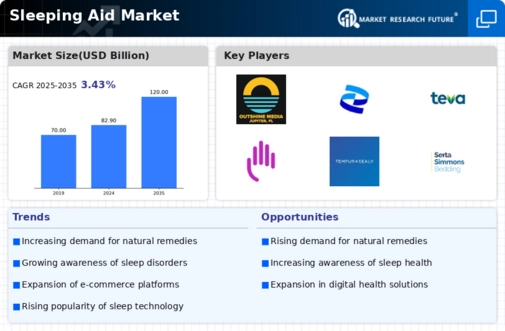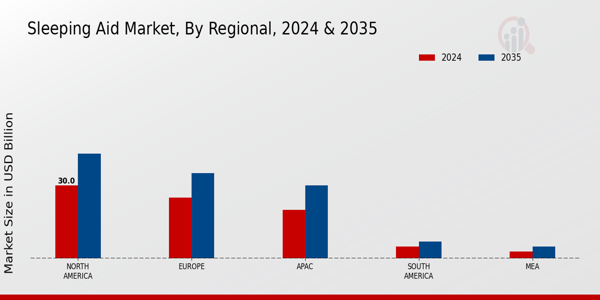Market Growth Projections
The Global Sleeping Aid Market Industry is poised for substantial growth, with projections indicating a market value of 82.9 USD Billion in 2024 and an anticipated increase to 120 USD Billion by 2035. This growth trajectory suggests a compound annual growth rate of 3.42 percent from 2025 to 2035. Such figures reflect the increasing consumer demand for effective sleep solutions, driven by various factors including rising sleep disorders, technological advancements, and changing lifestyles. The market's expansion may also be influenced by ongoing research and development efforts aimed at enhancing the efficacy of sleeping aids.
Aging Population and Sleep Needs
The demographic shift towards an aging population is likely to have a profound impact on the Global Sleeping Aid Market Industry. Older adults frequently experience sleep disturbances due to various health conditions and lifestyle changes, which may drive demand for sleeping aids. As the global population aged 65 and older continues to grow, the market could see a significant increase in consumers seeking solutions to improve their sleep quality. This demographic trend aligns with the projected market value of 120 USD Billion by 2035, indicating that the aging population is a crucial factor in shaping market dynamics.
Growing Awareness of Sleep Health
There is a notable increase in public awareness regarding the importance of sleep health, which seems to be influencing the Global Sleeping Aid Market Industry. Educational campaigns and health initiatives emphasize the critical role of sleep in overall well-being, potentially driving consumers towards sleeping aids. As individuals become more informed about the consequences of poor sleep, they may be more inclined to invest in products that promote better sleep quality. This trend aligns with the anticipated growth of the market, projected to reach 120 USD Billion by 2035, reflecting a shift in consumer behavior towards prioritizing sleep health.
Rising Prevalence of Sleep Disorders
The increasing incidence of sleep disorders globally appears to be a primary driver for the Global Sleeping Aid Market Industry. Conditions such as insomnia, sleep apnea, and restless leg syndrome affect millions, leading to a growing demand for effective sleeping aids. According to recent health statistics, approximately 30 percent of adults report experiencing sleep disturbances, which may contribute to the projected market value of 82.9 USD Billion in 2024. This rising awareness and diagnosis of sleep-related issues likely stimulate the market, as individuals seek solutions to improve their sleep quality.
Increased Stress and Lifestyle Changes
Modern lifestyle changes, characterized by heightened stress levels and irregular sleep patterns, appear to be a significant driver for the Global Sleeping Aid Market Industry. Factors such as work-related stress, technology use, and busy schedules contribute to sleep deprivation, prompting individuals to seek sleeping aids. The growing recognition of the link between stress and sleep quality may lead to increased consumption of sleep aids. This trend is reflected in the market's projected growth, with an expected value of 82.9 USD Billion in 2024, as consumers turn to various solutions to combat the adverse effects of stress on sleep.
Technological Advancements in Sleep Aids
Innovations in technology are reshaping the landscape of the Global Sleeping Aid Market Industry. The development of smart sleep devices, such as sleep trackers and app-integrated solutions, appears to enhance the consumer experience by providing personalized insights into sleep patterns. These advancements not only attract tech-savvy consumers but also contribute to the overall market growth. The integration of artificial intelligence and machine learning in sleep solutions may lead to more effective products, potentially increasing market penetration. As a result, the market is likely to experience a compound annual growth rate of 3.42 percent from 2025 to 2035.











